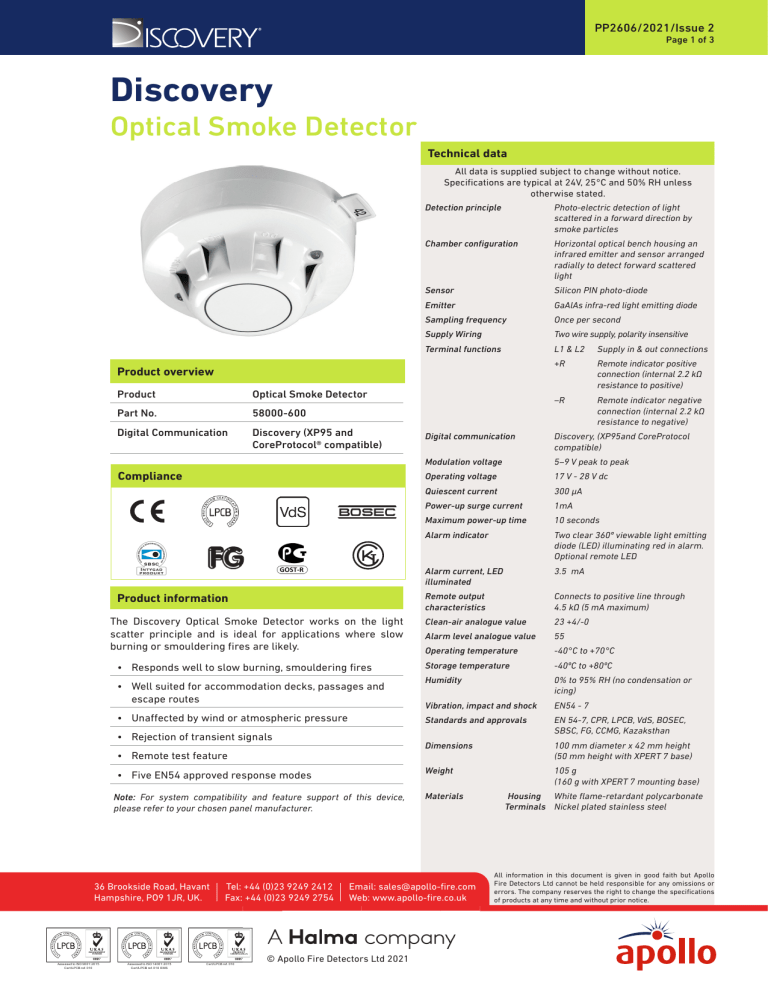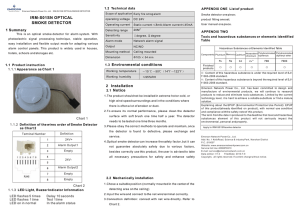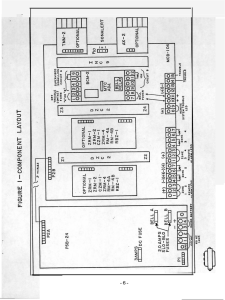
PP2606/2021/Issue 2 Page 1 of 3 Discovery Optical Smoke Detector Technical data All data is supplied subject to change without notice. Specifications are typical at 24V, 25°C and 50% RH unless otherwise stated. Detection principle Photo-electric detection of light scattered in a forward direction by smoke particles Chamber configuration Horizontal optical bench housing an infrared emitter and sensor arranged radially to detect forward scattered light Sensor Silicon PIN photo-diode Emitter GaAlAs infra-red light emitting diode Sampling frequency Once per second Supply Wiring Two wire supply, polarity insensitive Terminal functions L1 & L2 Supply in & out connections +R Remote indicator positive connection (internal 2.2 kΩ resistance to positive) –R Remote indicator negative connection (internal 2.2 kΩ resistance to negative) Product overview Product Optical Smoke Detector Part No. 58000-600 Digital Communication Discovery (XP95 and CoreProtocol® compatible) Compliance Product information The Discovery Optical Smoke Detector works on the light scatter principle and is ideal for applications where slow burning or smouldering fires are likely. • Responds well to slow burning, smouldering fires • Well suited for accommodation decks, passages and escape routes • Unaffected by wind or atmospheric pressure • Rejection of transient signals • Remote test feature • Five EN54 approved response modes Note: For system compatibility and feature support of this device, please refer to your chosen panel manufacturer. 36 Brookside Road, Havant Hampshire, PO9 1JR, UK. MANAGEMENT SYSTEMS Assessed to ISO 9001:2015 Cert/LPCB ref. 010 MANAGEMENT SYSTEMS Assessed to ISO 14001:2015 Cert/LPCB ref. 010 EMS Tel: +44 (0)23 9249 2412 Fax: +44 (0)23 9249 2754 PRODUCT CT TION CERTIFICATION Cert/LPCB ref. 010 Digital communication Discovery, (XP95and CoreProtocol compatible) Modulation voltage 5–9 V peak to peak Operating voltage 17 V - 28 V dc Quiescent current 300 µA Power-up surge current 1mA Maximum power-up time 10 seconds Alarm indicator Two clear 360º viewable light emitting diode (LED) illuminating red in alarm. Optional remote LED Alarm current, LED illuminated 3.5 mA Remote output characteristics Connects to positive line through 4.5 kΩ (5 mA maximum) Clean-air analogue value 23 +4/-0 Alarm level analogue value 55 Operating temperature -40°C to +70°C Storage temperature -40ºC to +80ºC Humidity 0% to 95% RH (no condensation or icing) Vibration, impact and shock EN54 - 7 Standards and approvals EN 54-7, CPR, LPCB, VdS, BOSEC, SBSC, FG, CCMG, Kazaksthan Dimensions 100 mm diameter x 42 mm height (50 mm height with XPERT 7 base) Weight 105 g (160 g with XPERT 7 mounting base) Materials Email: sales@apollo-fire.com Web: www.apollo-fire.co.uk © Apollo Fire Detectors Ltd 2021 Housing White flame-retardant polycarbonate Terminals Nickel plated stainless steel All information in this document is given in good faith but Apollo Fire Detectors Ltd cannot be held responsible for any omissions or errors. The company reserves the right to change the specifications of products at any time and without prior notice. PP2606/2021/Issue 2 Page 2 of 3 Operation Features The Discovery Optical Smoke Detector has a white moulded polycarbonate case with wind-resistant smoke inlets. The indicator LEDs are colourless when the detector is in quiescent state and red in alarm. Within the case is a printed circuit board which on one side has the light proof labyrinth chamber with integral gauze surrounding the optical measuring system and on the other the address capture, signal processing and communications electronics. Response modes An infrared light emitting diode within its collimator is arranged at an obtuse angle to the photo-diode. The photodiode has an integral daylight blocking filter. The IR LED emits a burst of collimated light every second. In clear air the photo-diode receives no light directly from the IR LED because of the angular arrangement and the chamber baffles. When smoke enters the chamber it scatters light from the emitter IR LED onto the photo-diode in an amount related to the smoke characteristics and density. The photodiode signal is processed to provide an analogue value for transmission when the detector is interrogated. Discovery Optical Smoke Detector schematic diagram Optical chamber Discovery Optical Smoke Detectors can be operated in any one of five EN54 approved response modes, which can be selected through the fire control panel. Each mode corresponds to a unique response behaviour, which is related to sensitivity to fire. Mode 1 gives a higher sensitivity to fire than Mode 5. Discovery Optical Smoke Detector Response Times Mode Alarm threshold (%/m) dB/m Minimum time to alarm (Seconds) 1 1.4 0.08 5 2 1.4 0.08 30 3 2.1 0.12 5 4 2.1 0.12 30 5 2.4 0.14 5 Flashing LEDs Address buttons Photo-diode Discovery Optical Smoke Detectors have two integral LED indicators, which can be illuminated at any time by the fire control panel to indicate detectors in alarm. A flashing LED mode can also be programmed to activate each time a detector is polled. Remote test feature PCB cover The remote test feature is enabled from the fire control panel. On receipt of the command signal from the fire control panel, the detector is forced electrically into alarm. An analogue value of 85 is returned to the fire control panel to indicate that the detector is working correctly. Case molding Infra-red LED Rejection of transient signals Discovery detectors are designed to give low sensitivity to very rapid changes in the sensor output, since these are unlikely to be caused by real fire conditions, resulting in fewer false alarms. Electrical description Drift compensation The Discovery Optical Smoke Detector is designed to be connected to a two wire loop circuit carrying both data and a 17 V to 28 V dc supply. The detector is connected to the incoming and outgoing supply via terminals L1 and L2 in the mounting base. A remote LED indicator requiring not more than 4 mA at 5 V may be connected between the +R and -R terminals. An earth connection terminal is also provided. The detector is calibrated to give an analogue value of 23 +4/-0 counts in clean air. This value increases with smoke density. A count of 55 corresponds to the alarm level analogue value. Discovery Optical Smoke Detectors include compensation for signal drift to compensate for changes in the sensor output caused, for example by dust in the chamber, and will therefore hold the sensitivity at a constant level even with severe chamber contamination. This increased stability is achieved without significantly affecting the detectors sensitivity to fire whilst still meeting the requirements of the EN54 standard. PP2606/2021/Issue 2 Page 3 of 3 EMC Directive 2014/30/EU The Discovery Optical Smoke Detector complies with the essential requirements of the EMC Directive 2014/30/EU, provided that it is used as described in this data sheet. A copy of the Declaration of Conformity is available from the Apollo website: www.apollo-fire.co.uk. Construction Products Regulation 305/2011/EU The Discovery Optical Smoke Detector complies with the essential requirements of the Construction Products Regulation 305/2011/EU. A copy of the Declaration of Performance is available from the Apollo website: www.apollo-fire.co.uk Discovery Optical Smoke Detector dimensions Response characteristics of Discovery Optical Smoke Detectors Type of fire Response Overheating/thermal combustion Very Good Smouldering/glowing combustion Moderate/Good Flaming combustion Good Flaming with high heat output Good Flaming - clean burning Poor




